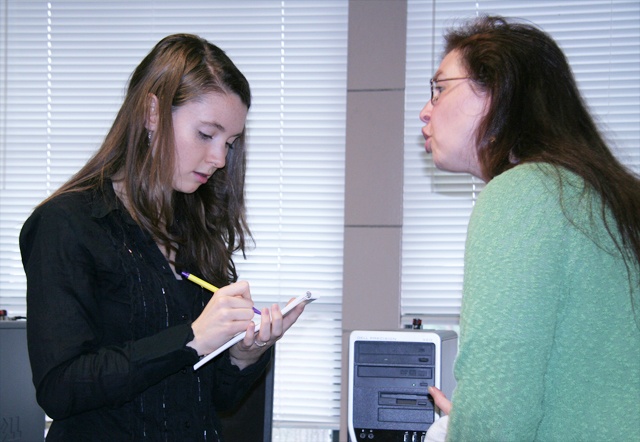Simulated Trauma in the Classroom
To prepare students to interview victims of traumatic events, journalism schools are using simulations and role-play. This guide shows educators how it's done.

Journalists who cover traumatic events such as violent crimes, horrific accidents, natural disasters and other situations in which they witness human pain and suffering are often required to approach and interview survivors of trauma or their family members.
Unfortunately the skills needed to interact with people under such stressful and unpredictable conditions do not usually come naturally. Without proper training, journalists may find their interviews with traumatized victims to be awkward, uncomfortable and, in extreme cases, even re-traumatizing.
Regardless of the reasons for a "bad interview," the end result is usually a poorer story than could have been written had a better interview been conducted. Interviewees may be reluctant to speak candidly — or at all — to an insensitive interviewer or to share treasured mementos such as a photograph of a deceased loved one. More importantly, interviewing survivors of trauma with sensitivity and professionalism demonstrates ethical behavior on the part of the journalist because it shows respect and empathy for the interviewee.
Dramatic interactions in journalism classes can help prepare students for real-life traumatic events they likely will face as journalists by allowing them to hone their interviewing and other social interaction skills in a realistic but practice environment. If student journalists can make their mistakes (or observe others making mistakes) during a simulation and then have those mistakes pointed out to them in a constructive way during a debriefing period, they are less likely to make those mistakes on an actual reporting assignment, where they could potentially (albeit unwittingly) harm their interviewees. Conversely, their "good habits" as interviewers can be reinforced through acknowledgement and praise. In either case, they come away with a better sense of how it looks and feels to interview people under traumatic circumstances.
At the University of Washington, professors use actors to help teach advanced reporting students about interviewing victims of trauma. Four actors from EffectiveArts, a Seattle-based simulation-based training and development company, portray survivors of a fatal apartment fire. After an introductory exercise, the actors are stationed around the classroom, each with important information to reveal and each in a state of shock, anguish, confusion, rage or some other emotion typically exhibited after a traumatic experience. Small groups of three to five student journalists work their way around the room, giving each student at least one opportunity to approach and interview a source while the others listen and learn.
An instructor or faculty coach accompanies each group and silently observes the five-minute interaction then facilitates a short discussion of what went well and what could be learned from each encounter. At the end of the exercise, the student journalists reflect on their own experiences, and receive feedback from the actors, who tell the class what they felt and observed as the interviewees. Feedback from those who have participated in these exercises has been positive, many expressing surprise at how real the simulation seemed to be. (For details on a sample curriculum for an exercise of this type, see Migael Scherer's Training Steps.)
The UW journalism collaboration began in 1997 between communications professor and Dart Center founding director Roger Simpson, who used interactive scenarios to teach trauma interviewing, and then-doctoral student Jim Boggs, who initiated a program that trained drama students to perform as actors for experiential learning exercises. Boggs has continued to develop the concept with EffectiveArts, which uses simulations to “help people be really, really good at high stakes interactions” in many arenas, including extremely sensitive conversations about organ donation.
Deep character development is the key, says Boggs. Rather than playing a role or learning lines, an actor steps into the skin of his or her character, and knows literally everything about the fictional person’s life. “It’s not acting; it’s being,” he says, and it quickly pulls the interviewer into the character’s world as well.
Boggs does not think it is necessary to use professionals, but he strongly recommends recruiting the actors from outside the journalism classroom. Working with the campus drama department is a win-win, he says, because it gives journalism students highly believable encounters and it gives drama students opportunities to perform profoundly significant roles. “It’s a profound gift to student actors to give them an opportunity to make a difference with their art,” he says.
Acting training helps actors “go into and [more importantly] out of ugly places,” he says. Not only are actors more believable than peers, they are free to push the student journalist in ways that a peer should not. There also are more emotional risks for untrained actors.
When untrained graduate students were used in the first trauma simulations at the UW, some complained of traumatic stress resulting from their inability to effectively separate their real emotions from those of the characters they were playing. Even with professional actors, Boggs carefully screens for recent, unhealed trauma that hits “too close to home” and would make a role emotionally inappropriate.
Peer role-playing also can play a part in classroom learning about trauma interviewing. It will not — and should not — have the same emotional impact on the interviewer or the interviewee, but it can help students practice approaching and interviewing a “victim” and it also can show them how it feels to be on the receiving end of a press encounter.


































































































